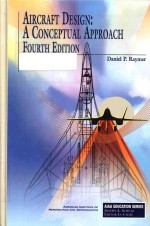图书介绍
aircraft design _ a conceptual approach fourth editionpdf电子书版本下载

- 著
- 出版社:
- ISBN:
- 出版时间:未知
- 标注页数:0页
- 文件大小:269MB
- 文件页数:857页
- 主题词:
PDF下载
下载说明
aircraft design _ a conceptual approach fourth editionPDF格式电子书版下载
下载的文件为RAR压缩包。需要使用解压软件进行解压得到PDF格式图书。建议使用BT下载工具Free Download Manager进行下载,简称FDM(免费,没有广告,支持多平台)。本站资源全部打包为BT种子。所以需要使用专业的BT下载软件进行下载。如 BitComet qBittorrent uTorrent等BT下载工具。迅雷目前由于本站不是热门资源。不推荐使用!后期资源热门了。安装了迅雷也可以迅雷进行下载!
(文件页数 要大于 标注页数,上中下等多册电子书除外)
注意:本站所有压缩包均有解压码: 点击下载压缩包解压工具
图书目录
1.Design—A Separate Discipline 1
1.1 What is Design? 1
1.2 Introduction to the Book 1
2.Overview of the Design Process 3
2.1 Introduction 3
2.2 Phases of Aircraft Design 3
2.3 Aircraft Conceptual Design Process 8
2.4 Integrated Product Development and Aircraft Design 12
3.Sizing from a Conceptual Sketch 15
3.1 Introduction 15
3.2 Takeoff- Weight Buildup 16
3.3 Empty-Weight Estimation 16
3.4 Fuel-Fraction Estimation 18
3.5 Takeoff- Weight Calculation 27
3.6 Design Example: ASW Aircraft 28
4.Airfoil and Geometry Selection 37
4.1 Introduction 37
4.2 Airfoil Selection 37
4.3 Wing Geometry 51
4.4 Biplane Wings 71
4.5 Tail Geometry and Arrangement 73
5.Thrust-to-Weight Ratio and Wing Loading 87
5.1 Introduction 87
5.2 Thrust-to-Weight Ratio 88
5.3 Wing Loading 94
5.4 Selection of Thrust to Weight and Wing Loading 110
6.Initial Sizing 111
6.1 Introduction 111
6.2 “Rubber” vs “Fixed-Size” Engines 111
6.3 Rubber-Engine Sizing 112
6.4 Fixed-Engine Sizing 118
6.5 Geometry Sizing 119
6.6 Control-Surface Sizing 123
7.Configuration Layout and Loft 127
7.1 Introduction 127
7.2 End Products of Configuration Layout 127
7.3 Conic Lofting 132
7.4 Conic Fuselage Development 138
7.5 Flat-Wrap Fuselage Lofting 146
7.6 Circle-to-Square Adapter 147
7.7 Fuselage Loft Verification 148
7.8 Wing/Tail Layout and Loft 149
7.9 Wetted Area Determination 161
7.10 Volume Determination 163
7.11 Use of Computer-Aided Design (CAD) in Conceptual Design 164
8.Special Considerations in Configuration Layout 169
8.1 Introduction 169
8.2 Aerodynamic Considerations 169
8.3 Structural Considerations 177
8.4 Radar Detectability 185
8.5 Infrared Detectability 195
8.6 Visual Detectability 196
8.7 Aural Signature 197
8.8 Vulnerability Considerations 197
8.9 Crashworthiness Considerations 199
8.10 Producibility Considerations 201
8.11 Maintainability Considerations 205
9.Crew Station, Passengers, and Payload 209
9.1 Introduction 209
9.2 Crew Station 209
9.3 Passenger Compartment 213
9.4 Cargo Provisions 214
9.5 Weapons Carriage 216
9.6 Gun Installation 219
10.Propulsion and Fuel System Integration 221
10.1 Introduction 221
10.2 Propulsion Selection 221
10.3 Jet-Engine Integration 224
10.4 Propeller-Engine Integration 250
10.5 Fuel System 257
11.Landing Gear and Subsystems 261
11.1 Introduction 261
11.2 Landing Gear Arrangements 261
11.3 Tire Sizing 266
11.4 Shock Absorbers 272
11.5 Castoring-Wheel Geometry 279
11.6 Gear-Retraction Geometry 280
11.7 Seaplanes 283
11.8 Subsystems 285
Intermission: Step-by-Step Development of a New Design 295
12.Aerodynamics 303
12.1 Introduction 303
12.2 Aerodynamic Forces 304
12.3 Aerodynamic Coefficients 308
12.4 Lift 309
12.5 Parasite (Zero-Lift) Drag 327
12.6 Drag due to Lift (Induced Drag) 346
12.7 Aerodynamic Codes and Computational Fluid Dynamics (CFD) 354
13.Propulsion 365
13.1 Introduction 365
13.2 Jet-Engine Thrust Considerations 367
13.3 Turbojet Installed Thrust 370
13.4 Thrust-Drag Bookkeeping 370
13.5 Installed-Thrust Methodology 371
13.6 Piston-Engine Performance 379
13.7 Turboprop Performance 386
14.Structures and Loads 389
14.1 Introduction 389
14.2 Loads Categories 390
14.3 Air Loads 392
14.4 Inertial Loads 402
14.5 Powerplant Loads 402
14.6 Landing-Gear Loads 402
14.7 Structures Fundamentals 403
14.8 Material Selection 408
14.9 Material Properties 413
14.10 Structural-Analysis Fundamentals 425
14.11 Finite Element Structural Analysis 443
15.Weights 451
15.1 Introduction 451
15.2 Approximate Group Weights Method 454
15.3 Statistical Group Weights Method 454
15.4 Additional Considerations in Weights Estimation 463
16.Stability, Control, and Handling Qualities 467
16.1 Introduction 467
16.2 Coordinate Systems and Definitions 469
16.3 Longitudinal Static Stability and Control 470
16.4 Lateral-Directional Static Stability and Control 490
16.5 Stick-Free Stability 499
16.6 Effects of Flexibility 499
16.7 Dynamic Stability 501
16.8 Quasi Steady State 505
16.9 Inertia Coupling 506
16.10 Handling Qualities 508
17.Performance and Flight Mechanics 515
17.1 Introduction and Equations of Motion 515
17.2 Steady Level Flight 516
17.3 Steady Climbing and Descending Flight 525
17.4 Level Turning Flight 529
17.5 Gliding Flight 532
17.6 Energy-Maneuverability Methods 536
17.7 Operating Envelope 544
17.8 Takeoff Analysis 546
17.9 Landing Analysis 550
17.10 Other Fighter Performance Measures of Merit 552
18.Cost Analysis 561
18.1 Introduction 561
18.2 Elements of Life-Cycle Cost 562
18.3 Cost-Estimating Methods 565
18.4 RDT&E and Production Costs 566
18.5 Operations and Maintenance Costs 570
18.6 Cost Measures of Merit (Military) 574
18.7 Aircraft and Airline Economics 575
19.Sizing and Trade Studies 579
19.1 Introduction 579
19.2 Detailed Sizing Methods 579
19.3 Improved Conceptual Sizing Methods 580
19.4 Sizing Matrix and Carpet Plots 585
19.5 Trade Studies 591
20.Vertical Flight—Jet and Prop 599
20.1 Introduction 599
20.2 Jet VTOL 599
20.3 Prop VTOL and Helicopter 619
21.Extremes of Flight 637
21.1 Introduction 637
21.2 Rockets, Launch Vehicles, and Spacecraft 637
21.3 Hypersonic Vehicles 649
21.4 Lighter-Than-Air 652
22.Design of Unique Aircraft Concepts 661
22.1 Introduction 661
22.2 Flying Wing, Tailless, Lifting Fuselage, and Blended Wing Body 661
22.3 Delta and Double-Delta Wing 666
22.4 Forward-Swept Wing 667
22.5 Canard-Pusher 669
22.6 Multi-Fuselage 670
22.7 Asymmetrical 672
22.8 Joined Wing 676
22.9 Wing-in-Ground Effect 678
22.10 Unmanned/Uninhabited 679
23.Conceptual Design Examples 683
23.1 Introduction 683
23.2 Single-Seat Aerobatic 684
23.3 Lightweight Supercruise Fighter 721
Appendix A.Unit Conversion 775
Appendix B.Standard Atmosphere 777
Appendix C.Airspeed 781
Appendix D.Airfoil Data 783
Appendix E.Typical Engine Performance Curves 795
E.1 Afterburning Turbofan 795
E.2 High-Bypass Turbofan 799
E.3 Turboprop 801
Appendix F.Design Requirements and Specifications 803
Questions 807
References 817
Index 825
Supporting Materials 839